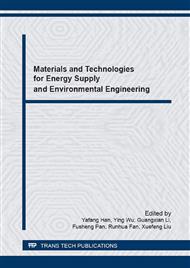p.143
p.148
p.153
p.161
p.166
p.171
p.177
p.184
p.190
Thermoelectric Properties of β-Zn4Sb3 Thin Films Deposited on Polyimide Flexible Substrate
Abstract:
Due to the high-performance in the medium temperature application, β-Zn4Sb3 thermoelectric material has been received much attention. It is found that low dimensional thin film can improve the thermoelectric properties of materials by quantum local area effect and interface effect in recent years. In this paper, the β-Zn4Sb3 thin film was prepared on polyimide flexible substrate by DC magnetron co-sputtering method. The results showed that the thin film exhibited predominately ZnSb phases when the thin film was prepared by DC magnetron sputtering using Zn4Sb3 alloy target. It is suggested that the element Zn has high saturated vapor pressure and the thin film is lack of Zn due to the evaporation during the heat treatment process. We further adopted co-deposition Zn and Zn4Sb3 by DC magnetron co-sputtering to supplement the content of Zn. The sputtering power of Zn4Sb3 is fixed and Zn is set to 21W, 27W and 34W, respectively. The results indicated that the thin films transformed from ZnSb phase into β-Zn4Sb3 phase after Zn added. EDS analysis demonstrated that the atomic ratio of Zn:Sb was approach 4:3, and a slightly surplus of Zn. The thermoelectric properties of thin films with β-Zn4Sb3 phase were improved obviously.
Info:
Periodical:
Pages:
166-170
Citation:
Online since:
March 2016
Authors:
Keywords:
Price:
Сopyright:
© 2016 Trans Tech Publications Ltd. All Rights Reserved
Share:
Citation:


